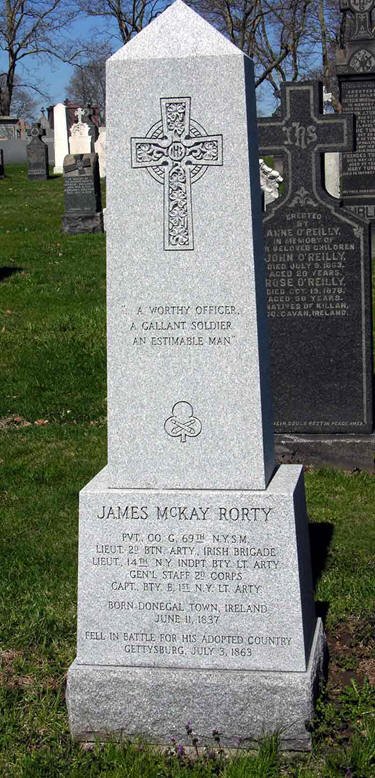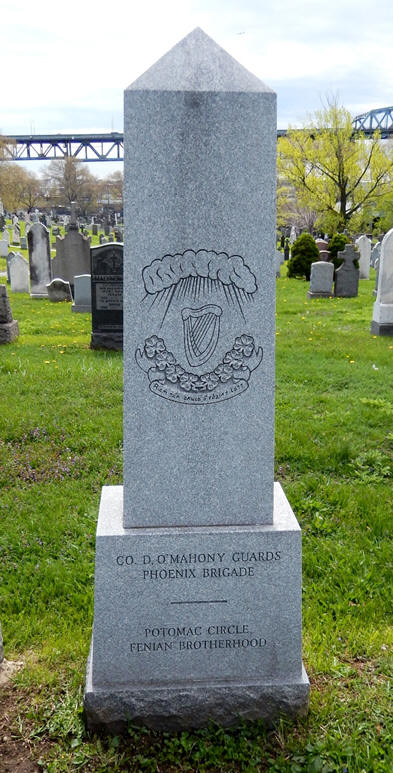|
James McKay Rorty (1837-1863)
Irish-born American soldier
and patriot, Fenian, Killed during Pickett's Charge on
July 3, 1863
 James
McKay Rorty was born in Donegal Town in Ireland on June 11,
1837. He was the oldest of ten children born to
Richard Rorty and his wife
Catherine.
As a young adult
he
witnessed the death, devastation and squalor caused by the
contrived famine of the 1840’s. There is no evidence to suggest
that he received any formal education, however, its evident from
his writings and successful military career that he was highly
intelligent, a keen student of history and a talented writer.
Little else is known of his early years in Ireland except,
as some accounts suggest, that he worked in the family's dry
goods business before emigrating to the U.S. in 1857. James
McKay Rorty was born in Donegal Town in Ireland on June 11,
1837. He was the oldest of ten children born to
Richard Rorty and his wife
Catherine.
As a young adult
he
witnessed the death, devastation and squalor caused by the
contrived famine of the 1840’s. There is no evidence to suggest
that he received any formal education, however, its evident from
his writings and successful military career that he was highly
intelligent, a keen student of history and a talented writer.
Little else is known of his early years in Ireland except,
as some accounts suggest, that he worked in the family's dry
goods business before emigrating to the U.S. in 1857.
After arriving in
U.S, he worked as a book canvasser, an occupation he described
in a letter to his father as "crippling my intellect, and
shattering my constitution". After his carrier as a book
canvasser ended he returned to the dry goods business before
enlisting in the army. During this period he brought two of his
siblings to the U.S and by 1863 had brought the rest of
his family along.
In 1859, Rorty signed on as a
member of Captain Phelan's Company D, the "O'Mahony Guards," one
of 40 independent companies comprising the Phoenix Brigade.
Rorty soon make a name for himself in Fenian circles as a
writer and orator. Michael Cavanagh, (a biographer of
Thomas Francis Meagher) described Rorty as
"a well-educated, gentle, unassuming in manner, and gifted with
a power of eloquence rarely vouchsafed to so young a man."
In April of 1861 at the onset of
the Civil War, Rorty enlisted in Company G of the
69th New York State Militia, a regiment commanded by
Colonel Michael Corcoran.
a founding member of the Fenian Brotherhood.
The
69th left Manhattan in late April for Washington DC. By
mid-July, after having spent several weeks constructing
defensive fortification in Arlington, the 69th set forth to
engage Confederate positions at Manassas in what was thought
would be a decisive Union victory that would bring the war to a
quick end.
Instead of the
anticipated easy victory Union forces were routed and
forced into a disorganized retreat back towards the Washington.
During the chaotic retreat, Rorty and many of his comrades were
captured as was Colonel Michael Corcoran. After two months in
captivity he made a daring escape from a Confederate prison in
Richmond, Virginia with two comrades. They all made good
their escape by successfully reaching the Union lines.
Rorty returned to New York where he
was officially mustered out of the 69th New York State Militia.
Succumbing to his parents wishes he promised not to re-enlist,
however, economic conditions and his penchant for army
life led him to change his mind. Seeking to justify
his decision he wrote a letter to his father explaining his
reasons for re-enlisting. Below is an excerpt from that
letter,
which is now
preserved in Rorty's military file in the National Archives in
Washington DC:
"But apart from the
motives of self interest, and the higher one of attachment to,
and veneration for the Constitution, which urged me to defend it
at all risks, there is another, and a deeper one still which
weighed heavily with me, namely the hope that the military
knowledge or skill which I may acquire might thereafter be
turned to account in the sacred cause of my native land. I may
state in this connection, that some time before the present
unhappy war broke out, I joined the Phoenix Brigade, an
organization of Irishmen similar in its objects to the United
Irishmen of bygone days, and had the honor to gain through some
essays I wrote and published in the organ of the brotherhood,
the friendship and approval of that single-minded patriot
John
O'Mahony Esqr." (Leader of the Fenian
Brotherhood, based in New York.)
In November of 1861 Rorty was
commissioned a 2nd, in the newly formed 5th Regiment of the
Irish Brigade by Thomas Francis Meagher. Shortly after receiving
his commission Rorty was presented with a saber, sash and belt
as a tribute by prewar comrades in the "O'Mahony Guards." In
thanking his comrades Rorty stated:
"My political faith as an
Irishman has only one article -- a firm belief in the future
resurrection of Ireland. And whether death meets me, as I hope
it will, on an Irish battlefield, or whether it overtakes me
battling for freedom on the hot plains of the South, it will
ever find me as firm in that faith as it finds the dying
Christian in the faith of his own resurrection."
During the Peninsula Campaign Rorty
served as Acting Ordnance Officer on the staff of General
Richardson. When Richardson was fatally wounded during the Union
assault on the heavily defended 'Bloody Lane' at
Antietam, Rorty was reassigned to the staff of Richardson's
replacement, Major General Winfield Scott Hancock. During
the Marye's Heights assault at Fredericksburg Rorty was wounded in the arm and
had his horse shot from under him. After recuperating from his
injury he returned to his duties and was engaged in combat at
Chancellorsville where he was singled out for praise for his
"gallantry" by Hancock. Shortly thereafter, he was
promoted to the rank of 1st Lieutenant.
During this period, Rorty
maintained his association with the Fenian Brotherhood and
served as Recording Secretary to one of the organization's
military subgroups, the Potomac
Circle.
When James Stephens
toured the U.S. during the civil war he met all the leading
American Fenians. Lieutenant James McKay Rorty, at the
time, Secretary of the network of about 30 Fenian Circles (in
effect, Companies), was viewed by Stephens as among the most
promising of the leaders. These Circles, usually led by
officers, were secretly organized in the two combatant forces,
though mostly in the Union army and navy.
In May of 1863 he
requested a short leave to return to New York to greet his
parents who had arrived from Ireland. After returning to duty he
was promoted to the rank of captain.
On July 2nd the
second day of the battle of Gettysburg, Rorty asked General
Hancock to take a more active role in the fighting. Hancock
acquiesced to his request and put him in command of
Battery B, 1st New York light Artillery
(once part of the Irish Brigade). On
July 3rd during the most critical and dramatic hour in American
history, known to the world as 'Pickett's Charge' Rorty was
mortally wounded while manning the last operable artillery piece
in what was a four gun battery.
Capt. P.J.
Downing of the 42nd NY, who had witnessed Rorty's heroic
final action wrote to Fenian chief John O'Mahony calling
Rorty's death , " as severe a loss as Ireland has had
in a long time."
Rorty was buried close to where he
fell. A few weeks later Richard Rorty, James' brother, came to
Gettysburg and returned his body to New York, where it was laid
to rest among many other Irish heroes of the Civil War in
Calvary Cemetery.
On May 29, 1993, one hundred and
thirty years after his internment, the badly weathered headstone
on Rorty's grave was replaced by the Donegal Association and the
Irish Brigade Association of New York City with the headstone
shown below.
Contributed by;
Tomás Ó Coısdealbha
Footnote:
Unknown to each
other, Captain Rorty and another Irish youth, 19-year-old
Private Willie Mitchel son of the incomparable Irish patriot,
John Mitchel, was killed
while bearing the regimental flag of the historic 1st Virginia
Infantry Regiment, Pickett's division, in the Confederate
service. Considering the position of Rorty's guns just 150 yards
directly opposite the Codori House where Private Mitchel fell
mortally wounded, it is within reason to believe that the fatal
explosive was fired from the single gun of Rorty's Battery still
manned by Rorty himself.
Cemetery AND grave location
Name:
Calvary Cemetery
ADDRESS:
49-02 Laurel Hill Blvd, Flushing, NY
11377
GRAVE LOCATION:
Plot: Section 5, Range 14, Plot U, Grave 9
HEADSTONE


FRONT
BACK
|